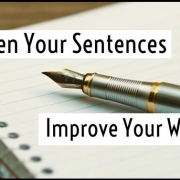What is the ideal length of sentences and paragraphs?
To what extent do wannabe/established writers and authors pay attention to the physical construction of their story? Note the deliberate distinction between the use of the words ‘writers’ and ‘authors’ – if for no other reason than the description of the two has always puzzled me, and perhaps needs clarification before we go much further.
So, let me digress onto this dangerous ground for just a moment.
Our reliably handy friends at Wikipedia describe authors as “the originators of any written word” whilst a writer is defined as “a person who produces literature or non-fiction, such as novels.” Confused? Wikipedia go on to tell us that “the term writer is customarily used as a synonym of author, although the latter term has a somewhat broader meaning.” Ah, that really explains things!!
At its most basic interpretation, you are an author if you ‘write’ fiction and a writer if you write non-fiction! Far be it from me to question Wikipedia, but are they seriously suggesting that a writer of fiction cannot be considered a writer? That’s just plain nonsense.
I was once told that as a day-to-day working journalist, a frequent features man, and an occasional magazine contributor, I could consider myself an “all-round writer” but that if I wrote a full-length novel I could consider myself an author. That piece of sageism was every bit as misleading as the definitions I’ve already covered.
Because of what I have done, and am doing, I have the right to describe myself anyway I like – forget scribe, narrator or storyteller, I am a writer AND an author! I would love to hear the views of all you writers and authors out there! What do you think you are?
But where was I? Oh, yes, I started out talking about sentence and paragraph construction. There are numerous pitfalls awaiting the unwary, and some thought should be given as to how your finished article actually looks.
Just to add to the quandary of writers (and authors) there are no industry rules or guidelines. You’ve got to go with your own style, mindful only that you want the reader to stick with you as he/she navigate their way through the lines you have created across the page.
For my own part I don’t like a sentence that goes beyond 6 lines. No amount of grammatical intersections (commas, semi-colons etc.) will compensate for the fact that by the end of the sentence the average reader will need to draw breath, and probably not want to be put through much more of the same.
There are exceptions, of course. It’s perfectly okay to have sentences in excess of 6 lines – just not every sentence (or even every fourth sentence). At the other end of the scale short, pithy sentences can be rather pleasant to encounter – provided they are not the norm for a book full of half-line or single-line offerings.
The same thought must be given to the length of paragraphs. If, for example, you push together two or three long-winded sentences into a paragraph you are in danger of taking up a complete page without the benefit of a break. The average paperback has 30-32 lines of text, compared to just 24 lines on a Kindle. I’ve seen too many Kindle books with paragraphs that fill the complete page, and then some. Not only does it not look right, but it also somehow doesn’t feel right.
I may be a writer and an author but I’m also a reader. When I come across a monstrosity such as I’ve just described, I invariably hit the ‘home’ button on Kindle and pick another book that will be less foreboding. Nowhere more than in books does the ‘quality-over-quantity’ adage most assuredly apply.
Beware going too far the other way! Unless you’re a James Patterson (and let’s face it, there’s really only one around!) stay away from 2- to 3-line paragraphs as a template for your style. It is one of the most difficult blueprints I can imagine.
When you progress from the length of sentences to the length of paragraphs, the next step is the length of chapters. I recently read a 360-page actioner that had just 8 (yes EIGHT) chapters. You do the math. For me, having to wait 35 pages for a break or a twist is really 27 pages too much. By now you’ll have guessed I’m an 8-page chapter kind of a guy. I can tolerate two pages either way, but beyond that I get a little frazzled. I dare say there are others like me.
Despite all I’ve said, there is nothing to beat a little mix-and-match. The very nature of stories is that you need to have creative licence to drop in both long and short variations of sentences, paragraphs, and chapters. However, do try to be a little consistent with your flow.
Whether you’re a writer, an author, or a reader you’ll know instinctively what I’m saying. If not, your editor (and you should always have one, particularly if you’re self-publishing) is bound to tell you.
Whichever way you go I’d love to hear your views – and I don’t mind what lengths you go to!
NOTE: The image shown above was taken from a post by https://www.writerswrite.co.za





Leave a Reply
Want to join the discussion?Feel free to contribute!